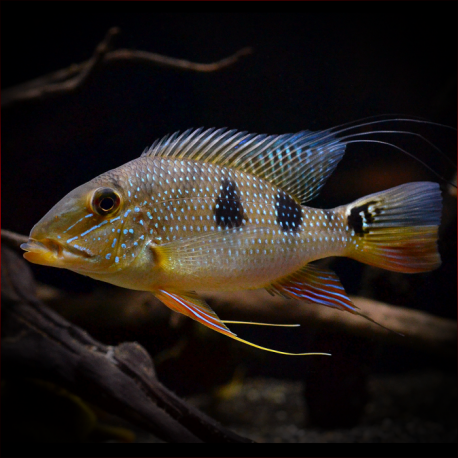More info
Datasheet
| Minimum Tank Size | 750 litres / 198.13 US gallons |
| Maximum Size | 25.0cm / 9.84inches |
| Temperature | 24°C / 75.20°F - 28°C / 82.40°F |
| Hardness | 1.01dgH / 18ppm - 5.04dgH / 90ppm |
| pH | 3.5-6.0 |
Behaviour:
The Threespot Eartheater is generally peaceful, excluding the breeding period when aggression may be observed. They do not prey on fish larger than a few millimeters and are compatible with peaceful species that share similar environmental preferences. It is advisable to avoid aggressive or territorial substrate-dwelling species. In some cases, aquarists have successfully housed Satanoperca spp. with freshwater stingrays, although instances of the cichlids disappearing at night have been reported. These cichlids tend to form loose aggregations unless spawning, and juveniles exhibit strong grouping instincts. A group of 5-8 individuals is recommended to establish a noticeable dominance hierarchy. When maintained in smaller numbers, weaker specimens may face excessive antagonism from dominant individuals or exhibit nervous behavior.
Feeding and Diet:
Threespot Eartheaters are benthophagous, feeding by taking mouthfuls of substrate to sift for edible items and expelling the remaining material. Their diet in the wild consists of small aquatic and terrestrial invertebrates, plant material, organic detritus, and sediment. In captivity, a varied diet of high-quality prepared foods, along with live or frozen options like bloodworms, Tubifex, Artemia, and mosquito larvae, is essential. Supplementing with vegetable matter is crucial. Home-made gelatine-bound recipes that include a mix of dried fish food, shellfish purée, fruits, and vegetables are recommended. Feeding smaller portions multiple times a day supports their natural browsing behavior, contributing to optimal growth and condition.
Reproduction:
Threespot Eartheaters are biparental substrate-spawners but are rarely bred in home aquaria due to certain requirements. Spawning requires ample space, appropriate diet, and strict maintenance practices. Accurately sexing these cichlids is challenging, recommending starting with a group of young fish to allow natural pair formation. Courtship behaviors involve fin flaring, circling, gaping, and head jerking displays. A pair will dig a large pit for spawning, defending the area before selecting a smaller site for egg deposition. Post-spawning, the adults care for the brood, with the female tending to the eggs and the male defending the territory. After hatching, the fry are guarded by both parents and can feed on live foods such as Artemia nauplii.
Habitat and Distribution:
Threespot Eartheaters are native to the rio Negro watershed in the Amazon basin, spanning Brazil, Venezuela, and Colombia. They inhabit acidic, mineral-poor blackwater environments with brownish, tannin-stained water. Typically found in areas with reduced water flow, their habitat consists of sand, leaf litter, fallen branches, and occasional aquatic vegetation. Tank setup for these cichlids should mimic their natural environment, including soft, sandy substrate, dim lighting, driftwood, and roots. Maintaining stable water conditions with soft, acidic water within specific parameters is crucial for their well-being. Regular water changes and appropriate filtration are essential for their health and growth.

